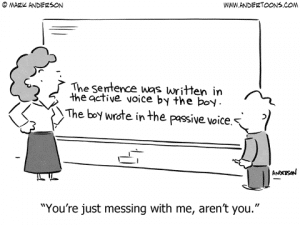Paint a Picture For the Reader Using Active Writing
I see it all the time. A writer has talent. Real talent for story telling. Story structure comes natural to them, and if they’re voracious readers, than that’s not a surprise. But the biggest problem I see in these talented writers is they don’t know how to paint a picture for the reader using active writing because they write in the passive voice. Passive writing can be good story telling, but active draws your reader into to story world and takes them on that emotional roller coaster ride they’re looking for.
Stephen King agrees that passive writing kills. Okay, not sure he actually said kill, but it seems to fit. Basically, what he says in his book On Writing: A Memoir of the Craft, is that passive writing and adverbs are two of the hallmarks of poor writing.

The sentence was written in the active voice by the boy.
What makes this cartoon funny is that it’s actually written in the passive voice. How can I tell? Take a look at the verb. Was written is passive because it uses a helping verb was.
Now let’s take a look at the next sentence.
The boy wrote in the passive voice.
Did you notice the verb? It’s active. It doesn’t have a helping verb which is passive. But what else is different about the two sentences? Okay, get really for a little grammar lesson.
Active Voice: shows the subject doing the action of the verb
Passive Voice: shows the subject receiving the action
So if you show the subject doing something you have active writing. Simple, right? But there’s another step to active writing.
It’s not enough to have the subject doing the action, but the word you choose to describe that noun and action (verb) should be the best possible descriptive word for the sentence. If you have to use an adjective or adverb, take another look at the noun and verb. Can you make it stronger? Is there another word that could describe the action better. Here’s a few examples:
Passive: It was raining outside
Active: The rain beat down on my window.
Passive: I felt like I was going to die.
Active: My insides ached so much my heart almost gave out.
Passive: I was going to the store.
Active: I ran to the store.
Passive: I was excited when I made the cheerleading squad.
Active: I jumped up and down when I made the cheerleading squad.
Passive: I felt sad
Active: Tears rolled down my cheeks
Can you see the difference?
Below is a list of passive words to look for (use the search and find feature in your document to find the passive words) in your story.
Is, was, be, are, been, felt, watch, saw, (any emotion like sad, happy, etc.) and ING words next to LY words (adverbs). Also do a search for the 5 senses words (taste, touch, feel, heard, saw) and you’ll probably find passive writing.
So what are you waiting for? Go paint a picture for the reader and watch your writing come to life.
***
Need help or support writing that book? Check out my online writing course and group “Release the Novel in You!” or get the DIY course workbook.
One on one coaching and tutoring is also available to writers of all ages!
Everything you need to get started on writing your story is in this course. Don’t put your dream off another day.